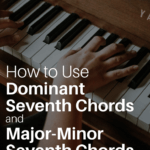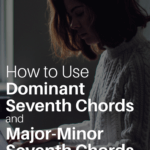Last Updated on October 12, 2022 by Rebecca
Disclosure: Please note that this article contains affiliate links, and that means that I may earn a commission if you buy something through my links. Read my full disclaimer here.
Tired of the same old sound from the same old triads? Learn how to use dominant seventh chords (also called major-minor seventh chords) to take your piano playing to the next level!
There are actually several different kinds of seventh chords. A seventh chord is a 4-note chord that consists of a triad with an additional note added a seventh above the root.
This post is all about the dominant seventh chord (also called the major-minor seventh chord). Keep reading and you'll learn what dominant seventh chords are, how to create them on any note, how to use them, why to use them, and how to practice them.
What is a dominant 7th chord?
Simply put, a dominant seventh chord is 4-note chord that consists of a major triad with a minor seventh above the root note.
For example, take a C major triad. That's the notes C-E-G. Now add a B flat to the chord (that's the note that is a minor seventh above C) and you've created a dominant 7th chord on C. In chord notation, you'd see this chord labelled as C7.
No time to read right now? Pin it for later!

How to Create a Dominant Seventh Chord
To build a dominant seventh chord, it's important that you're very familiar with major triads. If you're not confident with major triads yet, you'll want to start by learning about triads first, then practice your triads until you have them memorized.
The formula for a major triad is 4 + 3. To turn your major triad into a dominant seventh, you'll stack a minor third above your major triad. So the full formula for a dominant seventh chord is 4 + 3 + 3. But really, you just need to remember Major Triad + 3.
Let's create a C dominant seventh as an example.
To create a C dominant 7th chord:
- Start from your root C.
- Then count up 4 half steps to add the E a major third above the root.
- Then count up another 3 half steps to add the G a minor third above the E.
- Finally, count up another 3 half steps to add the Bb a minor third above the G.
Or, simply start with your major triad in root position and count up 3 half steps from the highest note to add the Bb.

Alternatively, you can add the 4th note by starting with your major triad, and adding the note 1 whole step below the octave above your root. (Remember, a whole step is the equivalent of 2 half steps).

Either way you do it, you'll end up with the correct notes for a C dominant seventh chord: C-E-G-Bb.
The Major-Minor Seventh Chord
As mentioned above, a dominant seventh chord is a 4-note chord that's built by adding a 4th note a minor third above a major triad.
This 4th note ends up being a minor seventh above the root of the triad.
So basically, a dominant seventh chord is a major triad plus a minor seventh. Which is why a dominant seventh chord is also called a major-minor seventh chord.
Major triad + minor 7th = major-minor 7th.
Truthfully, although most people call it a dominant seventh chord, the term major-minor seventh chord is actually a more accurate term to describe this particular chord as it's used in modern music. But don't let that stop you from calling it a dominant seventh, like everyone else does.
The Dominant Seventh Chord
In diatonic harmony, the major-minor seventh chord only exists on the dominant note (the 5th note) of the scale. So the reason it's called a dominant seventh chord is because it's a diatonic seventh chord built on the dominant note of the scale.
A diatonic chord (whether it's a seventh, a triad, or any other kind of chord) is one that is built using only notes that are present within a single scale. Diatonic harmony means using several chords that are all diatonic chords within the same scale.
C is the dominant note of the F major scale. The dominant seventh chord built on C includes the notes C, E, G and Bb, which are all notes that are part of the F major scale. These 4 notes create a major-minor seventh chord that is built on the dominant note of the F major scale.
If you try to build a major-minor 7th chord on any other note of the F major scale, you'll find it's impossible unless you use notes that are not present in the scale.
For this reason, during the common practice period, major-minor seventh chords were usually only used on the dominant note of the scale. Composers during that period just didn't typically use major-minor seventh chords on any note other than the dominant, and they didn't typically use any other kind of seventh chord on the dominant either.
If the chord was a major-minor seventh chord, it was built on the dominant. And if a seventh chord was built on the dominant, it was a major-minor seventh chord. As a result, people simply called it dominant seventh chord.
Dominant seventh = diatonic 7th chord built on the dominant note of the scale.

Major-minor 7th Chord vs. Dominant 7th Chord
As music evolved and it became more common to use non-diatonic chords within a piece of music, people started using major-minor seventh chords built on other notes of the scale as well, but the name dominant seventh stuck.
So technically a major-minor seventh chord is really only called a dominant seventh chord if it's built on the dominant note of a given scale. Technically, a major-minor seventh chord built on any note other than the dominant note of a given scale is not a dominant seventh chord. Nevertheless, musicians today tend to use the terms interchangeably and call all major-minor seventh chords dominant seventh chords.
Now here's where things get really brain-twisty.
(And feel free to ignore this box of text if your brain is starting to feel fried from all this music theory.)
Technically, the chord containing the notes C-E-G-Bb should be called a C major-minor seventh chord (because it's a major-minor seventh chord built on the root note C), or an F dominant seventh chord (because it's a diatonic 7th chord whose root note is the dominant note of the F major scale).
And technically, the term “C dominant seventh chord” actually means a chord containing the notes G-B-D-F (because these are the notes of the diatonic seventh chord whose root note is the dominant note of the C major scale).
But when you see the symbol C7 in music today, it means the chord containing the notes C-E-G-Bb, and people call it a C dominant seventh chord.
Dominant Seventh Chord Symbols
Root/Quality Chord Symbols
In root/quality chord symbols, a dominant seventh chord is represented by the root of the chord followed by the number 7. For example, a C dominant seventh chord is represented by the symbol C7. And this means a major-minor seventh chord built on the root note C, with the notes C-E-G-Bb.
Functional Chord Symbols
Functional chord symbols are based on diatonic harmony. So in functional chord symbols, a dominant seventh chord exists only on the dominant of a given scale. For this reason, dominant seventh chords are represented by the Roman numeral V (to represent the dominant scale degree) followed by a number 7 (to indicate the chord is a seventh chord). For example, in the key of C, the dominant seventh chord built on G would be represented by the symbol V7, and would include the notes G-B-D-F.
Why Use a Dominant Seventh Chord?
Using the Dominant Seventh Chord in an Authentic Cadence
The authentic cadence is used to create a feeling of completeness at the end of a musical phrase. It's like a period at the end of a sentence. And it's especially common to use an authentic cadence at the very end of a piece of music.
To create an authentic cadence, you move from the dominant triad of the scale, to the tonic triad of the scale. (The dominant triad is built on the 5th note of the scale, and the tonic triad is built on the first note of the scale).
For example, in the key of F major, you would create an authentic cadence by moving from the C major triad to the F major triad
The dominant triad contains the leading tone (the note 1 half step below the tonic note) which is a very dissonant note that naturally wants to lead to the tonic note (the first note of the scale).
So when you move from the dominant triad to the tonic triad, you resolve the dissonance of the leading tone by moving it to the tonic note in the tonic triad. This resolution is what creates the feeling of completeness in an authentic cadence
By using a dominant seventh chord instead of a basic dominant triad in an authentic cadence, you add extra dissonance to the dominant chord.
In a dominant seventh chord, you have 3 elements of dissonance:
- The leading tone.
- The minor seventh interval between the root and the top note (the 7th) of the chord.
- The tritone interval between the 2nd and 4th notes of the scale.

When you move from the dominant seventh chord to the tonic chord, you resolve all 3 of these layers of dissonance. As a result, you get an even stronger feeling of satisfaction and completeness in your authentic cadence.
Other Uses of the Dominant Seventh Chord
Using the dominant 7th chord in authentic cadences is a tradition from the common practice period in music history.
As discussed above, it's quite common in modern music for these so-called dominant seventh chords to be built on notes other than the dominant, in which case they would really have no place in an authentic cadence.
So now musicians (and especially jazz musicians) often use dominant seventh chords just to add colour or interest to a piece of music, without necessarily resolving the dissonances.
So feel free to experiment with dominant seventh chords. Use them starting on any note of a scale (not just the dominant), and follow them with any other chord. Obviously, they'll sound better in come contexts than others, but you should allow yourself to experiment and use your ears to decide what sounds good to you!

Inversions of the Dominant Seventh Chord (Major-Minor Seventh Chord)
Like any chord, the dominant seventh chord can be inverted. Including root position, there are 4 inversions of the dominant seventh chord. To invert a chord, simply move the lowest note up an octave.
For example:
- You could play a C7 chord in root position (C-E-G-Bb)
- Or you could move the C up an octave to play the chord in 1st inversion (E-G-Bb-C).
- You could also play the chord in 2nd inversion by moving the E up an octave as well (G-Bb-C-E).
- You could even invert the chord yet again and play it in 3rd inversion by moving the G up an octave as well (Bb-C-E-G).

Tip: 7ths chords in 2nd or 3rd inversion are easier for pianists with small hands.
How to “Cheat” the Dominant Seventh Chord
You can “cheat” the dominant seventh chord by omitting the 3rd note of the chord (called the 5th because it's a fifth above the root of the chord).
There are 3 reasons why you might want to cheat the dominant seventh chord:
- It's often very difficult (or even impossible) for pianists with small hands to play 4-note chords in solid/blocked form. The fingers often just can't make the shape.
- Beginners often find it easier to learn 3 notes than 4 notes.
- It creates a variation to the sound, while still maintaining the distinctive sound of a dominant seventh chord.
You can omit the 5th from any inversion of the dominant seventh chord. However, notice that when you omit the 5th, the 2nd and 3rd inversions of the chord become identical. In the diagrams below, the C7 chord is used as an example, with the fifth (G) omitted from each inversion.

It's important to note that you should not omit any other notes of the dominant seventh chord.
- The root of the chord is necessary because it establishes the chord's identity. (You shouldn't omit the root from any chord.)
- The 4th note of the chord is important because it's the 7th… without it you don't have a dominant seventh chord, you just have a regular triad.
- The 2nd note of the chord is important because without it you don't have the tritone interval.
How to Practice Dominant Seventh Chords
Now that you understand how dominant seventh chords work, it's time to get comfortable actually playing them!
The best way to practice dominant seventh chords is focused repetition. One of the resources I offer in my post on how to practice piano chords is the 60-Second Chord Challenges package. You can read through that post for more information about practicing piano chords.
Another important way to practice dominant seventh chords is to use them in music. It's great to be able to play chords in drills, but what's the point if you don't take the chords you've practiced and apply them in a musical context?
So challenge yourself create your own piano improvisations and incorporate some dominant seventh chords in them! Or head over to Ultimate-Guitar.com and find the chords for a song you love that includes dominant seventh chords!
Piano Chords Bonus Tip
One final tip to help you incorporate dominant sevenths (or any chords) into your piano playing… no one ever said you have to play all the notes of a chord with one hand! Feel free to experiment and split the notes between your hands.
- Try playing the lowest note in your left hand with the remaining 3 notes in your right hand.
- Or try the reverse, playing the 3 lowest notes in your left hand with the remaining top note in your right hand.
- Or split it down the middle and play the bottom 2 notes in your left hand with the top 2 notes in your right hand.
More Types of Seventh Chords
Often, when people talk about seventh chords, they're talking about the dominant seventh.
But the truth is, the dominant seventh chord is only one of 9 different types of seventh chords!
You don't need to learn all of them, but it's definitely worth learning a few more once you've mastered the dominant seventh!



